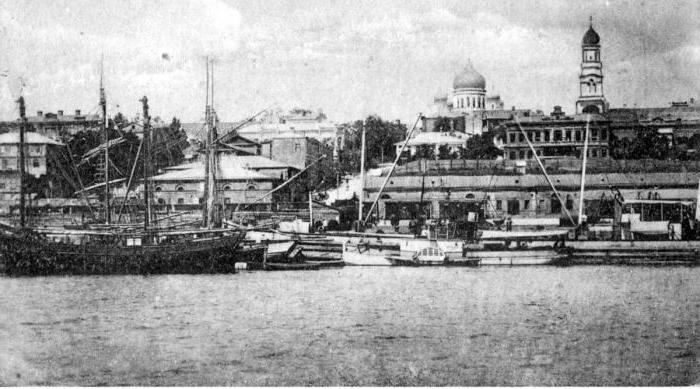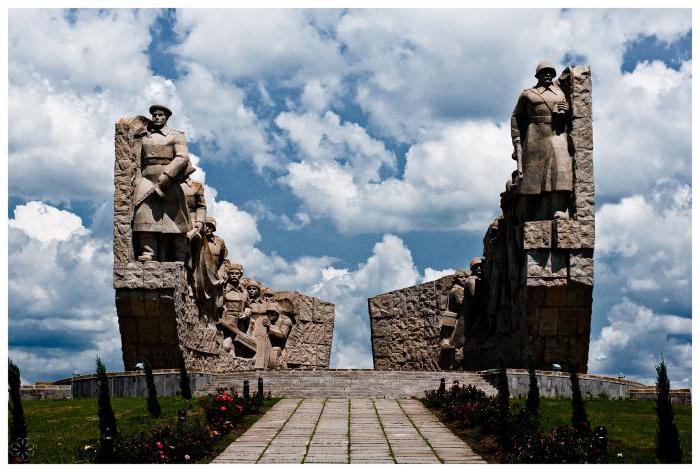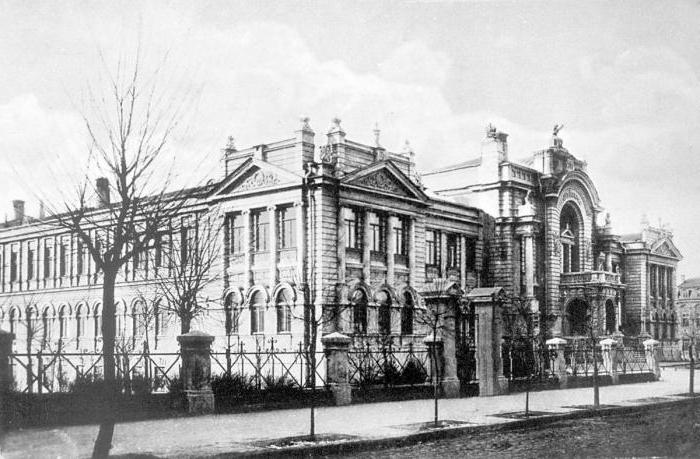"Rostov-papa" - so affectionately called one of the largest cities in southern Russia. Why and how did he fall in love with his inhabitants? Why do visitors and guests respect him? Why is it so important for the development of not only the region, but the whole country? The history of the city is multifaceted: it has repeatedly changed its name, expanded and rebuilt in accordance with the new tasks of the city and the aspirations of the townspeople. The population of Rostov is constantly growing. It attracts many people from other places, as it provides many opportunities for development and a comfortable life.

Foundation of the city
The city was founded by order of Empress Elizabeth Petrovna in 1749. The place was chosen for strategic reasons to protect the southern borders of the Russian Empire. Initially, it was the Temernitsky customs. Subsequently, they laid down a fortress named after the bishop of the Russian Orthodox Church Dmitry Rostovsky. The population of Rostov was initially engaged in the defense and strengthening of the country's borders. In addition, the city is located just 46 kilometers from the confluence of the Don River into the Sea of Azov. Not so far away is the capital, Moscow - 1092 kilometers from the city.
However, 1749 is the year of the official consolidation of the city status for this settlement. But historically, these places were populated long before the city itself appeared. Archaeologists date the remains of the first dwellings III millennium BC. But more or less modern history is directly connected with the first Russian emperor Peter the Great, who waged the Azov Wars and for which it was fundamentally important to take these places. He wanted to lay a fortress in the Don river valley, but was bound by the provisions of the Prut Treaty between Russia and Turkey, according to which Russia could not continue military expansion to the south and gave Turkey Azov.

City development
Subsequently, the will of Peter was fulfilled by his daughter, Elizaveta Petrovna, and on December 15, 1749 she signed a decree on the creation of the Temernitsky customs, with which the development of a large modern city began. In the shortest possible time, the Temernitsky port was built here, which became the only one in the southern part of the empire, and through which trade was conducted with the countries of the Black and Mediterranean Seas. The population of Rostov-on-Don increased every year, thanks to the opening up trade opportunities.
Ten years later, construction began on the fortress, designed to protect the population of the city of Rostov-on-Don from regular raids by Turks and Crimean Tatars. It was a very large and powerful fort, with a circumference of 3.5 kilometers. On the territory there was a garrison of four thousand people. About a thousand more soldiers lived in the nearest streets and in the settlements.

Military significance
The population of Rostov was initially ready to strengthen and protect the southern borders of the country from warlike raids by neighbors, who always had views of these territories, due to their strategic importance. During the hostilities it was extremely important to have access to the sea and navigable rivers, one of which is the Don.
It is noteworthy that at the end of the XVIII century the commandant of the city was the great Russian commander Alexander Suvorov. By that time, the population of the city of Rostov had increased several times, commensurate with the changed value of this settlement in the internal and external affairs of the empire.
Rostov-on-Don played a decisive role during the Great Patriotic War. Here is one of the largest places of extermination of Jews by fascist invaders, who occupied the city twice, in 1941 and 1942. It was possible to finally release him only in 1943.
Myths and legends
As in many other cities and villages of Russia, there are many secrets and myths that have enveloped the city of Rostov. The population and guests know a lot of amazing stories about this city. One of them is the legend of the golden horse of Genghis Khan, which was hidden in one of the places on the banks of the Don. They say that he was cast from one hundred percent gold, and brave Cossacks who were not afraid to get into the camp of Genghis Khan stole it. According to legend, the Cossacks were caught and executed, but they could not find the horse. How can not find him many treasure hunters who believe that this myth may be true.
Another urban legend that the population of Rostov is actively disseminating is about long underground tunnels. Rostov dungeons are notorious among ufologists and fans of mystical stories. They say that about 20 years ago, workers descended into one of these dungeons to carry out repairs on the surface of structures. However, there they encountered some disgusting creatures that were not like any of the animals known to science. Many workers were in a state of shock and could not plainly explain that they were so scared underground.
The population of Rostov is growing, new myths come along with new settlers, and old ones are overgrown with colorful details and details.

sights
In the process of creating the city, many interesting buildings and monuments were erected that would be of interest to both residents and visitors.
First of all, the main street of Rostov is known - Bolshaya Sadovaya. It was laid in the first decades of the city. Initially, she was extremely unattractive and uncomfortable. Her appearance was taken only a century later. Here are the few buildings and structures that survived from imperial times. However, even a little of the surviving is of great interest. Guests and the population of the city of Rostov-on-Don love to walk along this picturesque street.
Well, the second most popular place is, of course, the embankment of the Don River. Here you can sit on one of the benches in the shade of tall trees and watch the ships passing by. The higher the population of Rostov-on-Don, the more vacationers are here, the services of which are open to numerous cafes and restaurants, as well as a variety of attractions.
Heroes and Celebrities
The city has something to brag about - it has become the birthplace of many famous people. About 10 years ago, they even opened their own Avenue of Stars, where once a year they lay another commemorative sign dedicated to the honorary citizen of Rostov. Such celebrities as Sergey Bondarchuk, Mikhail Sholokhov, Anton Chekhov, Mikhail Gnesin were born, lived and created at different times here. Dmitry Dibrov, Irina Allegrova and many other figures in show business are also associated with Rostov.

Economic importance
After the Temernitskaya customs lost its original military significance, the population of Rostov-on-Don was actively engaged in trade. This was facilitated by the geographical location of the city next to the navigable river, which helped connect merchants and traders with potential buyers and producers of various goods. Annual fairs were held here, and the largest of them, in September, was considered one of the most important and representative in the entire southern part of Russia.
Later, the shipbuilding industry began to develop here, which gave a new impetus to the growth of the city. By the end of the 19th century, dozens of factories and factories were operating in Rostov, employing thousands of skilled workers. At the beginning of the XX century, the city was actively expanding, its territory was constantly expanding. A decade later, trade representative offices and consulates of the largest countries in Europe and America were opened here.
After the construction of the Volga-Don Canal, Rostov became the "city of five seas", since now ships could sail through canals anywhere in the world.
Culture and art
Rostov-on-Don is not only a large commercial and regional center, but also a cultural city. Dozens of libraries have been built and operate here, there are several theaters and even their own film studio. In Rostov, many museums are opened, which display unique exhibits that can surprise even very demanding connoisseurs.
For the entertainment of citizens, a zoo, two circuses, a water park, a dolphinarium and many other entertainment facilities are open. In this city, various social cultural events are held, so you do not have to be bored.
The city played an important role during the Great Patriotic War, therefore, in Rostov and the district there are many monuments to fallen soldiers, and he himself received the title of City of Military Glory. During the fighting, only the ruins remained of most structures, but the city began to be restored very quickly.

International relationships
Rostov-on-Don has not only regional significance, but also a high international status. This emphasizes the presence of visa centers of leading European and world powers. The population of Rostov travels a lot, not only to relax, but also with business intentions.
On one of the streets is the honorary consulate of South Korea, as well as the South Korean cultural center, which introduces the townspeople to this distant eastern country.
Rostov has overseas twin cities, including Turkish Antalya, French Le Mans and the Finnish city of Kajaani. The complete list includes nearly two dozen cities around the world.
Modernity
At the moment, the population of Rostov-on-Don is just over 1.1 million people. And this figure is constantly growing. The city attracts young people, as it provides many opportunities for quality education, gives prospects for development and comfortable life on the banks of one of the most significant rivers in Russia. No wonder it is called the southern capital of Russia, since the business life of the south of the country is concentrated here.
The city’s economy is developing, large and small businesses have good opportunities for prosperity.

Future plans
In Rostov one can feel the breath of change, youth, hope for the future. Residents of the city are very friendly and hospitable, always ready to talk for hours about their favorite city. Many who came here for a while remain forever, since they can no longer imagine their life without Rostov, without a river, without its embankment. New companies, representative offices of the largest international corporations are opening in the city. Everyone can find something for everyone and for the soul.
There are many hotels in Rostov for city guests who come for business and tourist purposes.
At the end of the 20th century, in 1999, Rostov-on-Don celebrated its 250th anniversary, summed up the interim results and outlined new goals for the future. After the transition period, the economic downturn associated with the disappearance of the USSR, many industrial enterprises that were previously closed again began to work in the city. The city knows its problems and works to eliminate them and make it even more attractive and comfortable for residents and guests.








